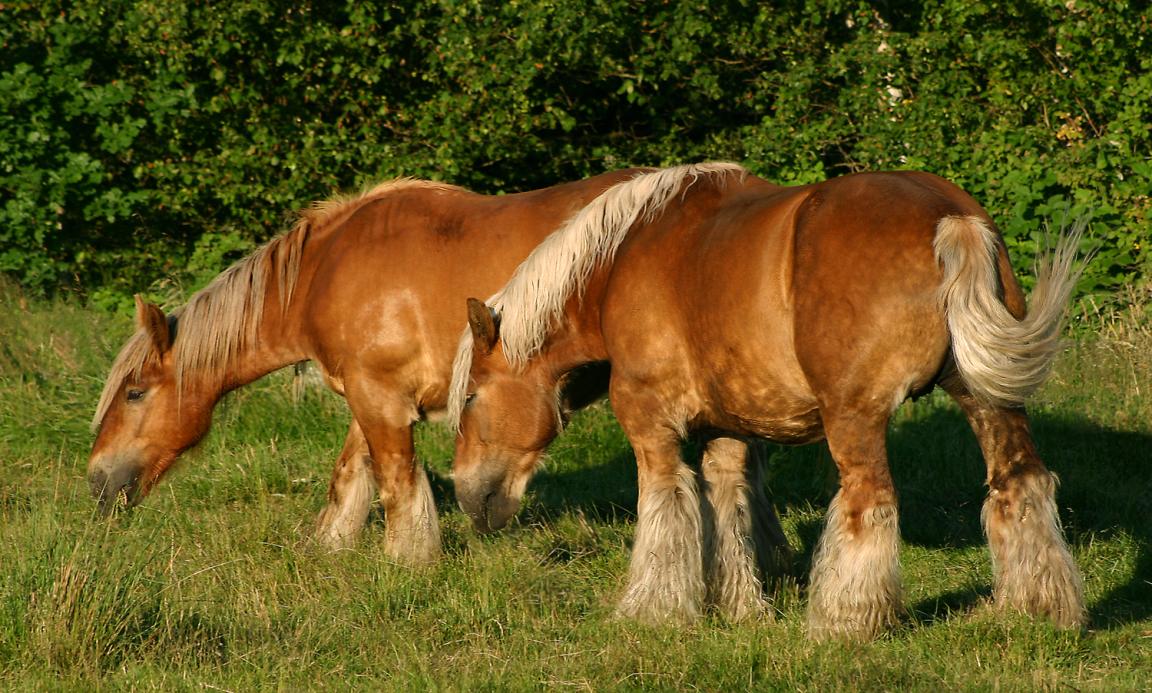
Continent: Europe
Country: Denmark
Weight: 650 – 800 kg
Height: 152 – 165 cm
The Jutland horse originates from the Jutland Peninsula, the continental region of Denmark. This heavy draft breed has been shaped over centuries by the specific demands of the northern, humid, and harsh climate of the area.
The Jutland has its roots in a long-standing Danish agricultural tradition, where it was mainly used for fieldwork, heavy draft, and transportation, and gained fame through its use by renowned Danish breweries, most notably Carlsberg, which helped turn the breed into a true national symbol.
Historically tied to Danish rural culture, the Jutland horse remains a valuable part of Denmark's agricultural and cultural heritage, embodying strength, endurance, and authentic Scandinavian identity.
The Jutland horse is mainly bred in its native region, the Jutland Peninsula of Denmark, which remains the historical and current center of its production. Notably strong breeding traditions are found in Central and Southern Jutland, especially around the cities of Aarhus, Randers, and Viborg.
This region’s humid temperate climate and heavy, fertile soils align perfectly with the Jutland’s natural qualities. While smaller breeding populations exist in other parts of Denmark and Scandinavia, they remain very limited compared to the Jutland core.
The Jutland horse represents an essential genetic heritage among European heavy draft breeds, particularly within Denmark and more broadly across Scandinavia. It serves as a valuable genetic reservoir, possessing traits that have become increasingly rare in modern breeding, such as robustness, resistance to harsh climatic conditions, and strong muscular capacity for draft work.
The Jutland is particularly known for transmitting its massive and compact conformation, solid limbs, and excellent hoof quality, making it ideally suited to the heavy, wet, and clay-rich soils of its native region. These traits, refined over centuries through the strict selection operated by the Danish stud-book (Avlsforeningen Den Jydske Hest), make the breed of significant interest for conservation programs and sustainable breeding.
From a genetic standpoint, preserving the Jutland is even more critical as it is classified among endangered breeds, with a low overall population. Maintaining diverse and well-documented bloodlines in the stud-book helps ensure equine biodiversity, which is crucial in preventing risks related to inbreeding and genetic disorders.
Finally, the Jutland holds symbolic and practical genetic value as a potential contributor to the improvement of other heavy draft breeds, particularly through its bone strength, exceptional hoof structure, and its calm and cooperative temperament.
Thus, the genetic preservation of the Jutland extends beyond national interest, offering broader relevance in terms of international equine selection.
The history of the Jutland horse dates back to the Middle Ages, but the breed truly developed during the 19th century through targeted crossbreeding with other European heavy draft horses such as the English Shire, Suffolk Punch, and Belgian draft breeds. These crosses helped shape the Jutland’s massive build and its distinctive chestnut coat.
In 1887, the creation of the official stud-book (Avlsforeningen Den Jydske Hest) marked a major milestone in the breed’s history, leading to systematic and rigorous selection.
At the beginning of the 20th century, the Danish brewery Carlsberg significantly boosted the Jutland’s reputation by using the breed exclusively for deliveries. Despite a sharp decline in numbers following agricultural mechanization, the breed endures today thanks to its strong historical and cultural significance.
The Jutland horse is known for its calm, docile, and cooperative temperament, making it an ideal partner for draft work and carriage driving.
This balanced character is complemented by natural gentleness and impressive resistance to stress and prolonged effort, traits essential in traditional farm work and public demonstrations.
Thanks to its steady and reliable demeanor, the Jutland is also well-suited for regular interaction with the public, including in cultural events and festivals, where its patience and behavioral stability are particularly appreciated.
Though the outlook for the Jutland breed is mixed, there are several encouraging developments. Currently listed as an endangered breed, it benefits from active conservation efforts led by the official association (Avlsforeningen Den Jydske Hest) and supported by the Danish government.
Specific initiatives are being developed to promote the Jutland in traditional agricultural demonstrations, tourist carriage driving, and equestrian shows, providing the breed with greater public visibility.
Furthermore, a renewed interest in traditional farming methods and local cultural heritage is creating promising opportunities for this heritage breed, offering a future that, while niche, appears stable and sustainable.
The Jutland is generally a healthy and hardy horse, highly resistant to harsh climatic conditions. However, like many heavy draft breeds, it may be predisposed to certain genetic or size-related conditions.
Common concerns include a susceptibility to osteochondrosis (OCD)—a joint disorder frequent in heavy breeds—and a tendency toward equine metabolic syndrome or obesity if not properly managed with diet and exercise.
Fortunately, the Jutland’s strong limbs and solid hooves make it far less prone to hoof and tendon issues, provided the horse receives regular and appropriate care.
The driven walk of the Jutland is a four-beat gait, regular and powerful. It is characterized by great stability, moderate amplitude, and a calm yet steady impulse. For draft horses like the Jutland, this gait is essential for traction work, as it allows for continuous movement without abruptness, while maintaining balance under load.